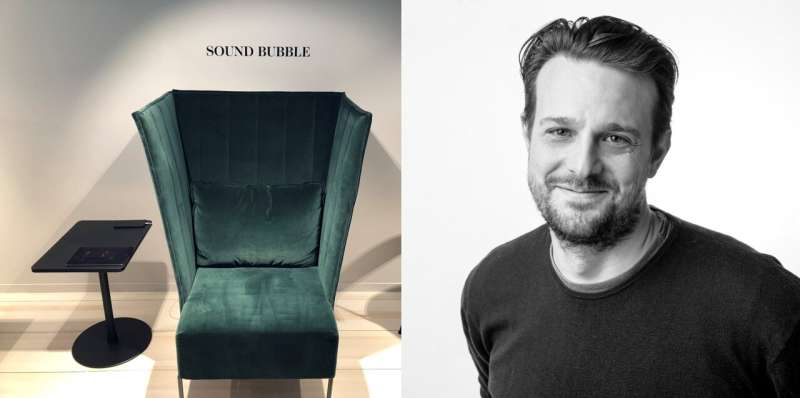This article has been reviewed according to Science X's editorial process and policies. Editors have highlighted the following attributes while ensuring the content's credibility:
fact-checked
proofread
Bubbles create better sound environments in open offices

Over the past 20 years, most indoor work spaces have transitioned from individual offices where one could close the door, to open work spaces where many share the same space. A new doctoral thesis from the University West examines whether the increasingly poor sound environment can be made more pleasant through innovative sound design.
Martin Ljungdahl Eriksson is a third-party doctoral student in informatics specializing in Work-Integrated Learning. His doctoral thesis "Space in the Space—Designing Sound Environments for the Shared Indoor Workspace" explores possible design solutions for offices to create better sound environments. But before we get there, Martin wants to clarify what the problem is.
"The point of open work spaces is that they should lead to some form of knowledge sharing and better communication. However, research is inconclusive on whether open work spaces actually lead to increased knowledge sharing.
"Several studies suggest that open offices may lead to decreased communication. There's too much going on, and the sound environments are very poor. The traditional way of solving this has been to dampen the sound since it's perceived negatively. But that has resulted in environments that are too quiet; we hear our colleagues' conversations, which disturbs us cognitively, making it hard to focus on work."
Prototype with background sound
Ljungdahl Eriksson has been interested in sound throughout his professional life. First, he studied sound engineering and sound design, then worked with Soundscaping, which involves creating sound for different locations. For the past seven years, he has been researching sound design.
In his doctoral thesis, he has developed a solution: an office chair prototype with speakers in the headrest. In it, Ljungdahl Eriksson has designed background sound that creates a sound bubble or a transparent layer of sound. But he has also looked at prototypes in the form of a tabletop and an armchair.
"If we think differently, I'm convinced that we shouldn't just focus on removing sound. We need to use sound as a design element, but it must be pleasant and a sound you don't really notice, which half-protects you from the surroundings. It shouldn't be entirely isolating like headphones, but you should be able to participate in conversations if you want to. Otherwise, we lose the point of open office environments," says Ljungdahl Eriksson.
Ljungdahl Eriksson emphasizes that the prototype's task is not about completely enclosing or shutting out. It should also not play music through the speakers. Instead, it should be a sound that is pleasant but not something you actively listen to, something not too interesting but still intriguing enough not to get tired of. This allows you to decide whether you want to participate in colleagues' conversations or be by yourself. The sound bubble does not shut out everything but is transparent.
"It should be like working in a café. When you find your flow in such an environment, it's because you don't have to focus on other guests' conversations. There are only pleasant, non-essential sounds around you. In short, we give the user power. In today's workplaces, we are imposed sound environments we have no control over. With a solution like this, the user can choose their own sound environment."
Pleasant, melodic sounds with resonance
During three cycles, Ljungdahl Eriksson has examined design possibilities and prototype implementation by studying how users experience and shape their sound environments. He has also conducted laboratory research, surveys, field tests in four different offices, and interviewed professionals in indoor environment design.
So, what type of sounds has proven to work in Ljungdahl Eriksson's research? There's no clear answer to that question. He tried designing sounds based on nature, like wind, a bubbling brook, and a tranquil forest. He tested café chatter and coloring the room's sounds but discovered that people wanted to make the sounds even more pleasant, more melodic, with more resonance. Most people didn't want pure natural sounds. They wanted to configure the sound environment based on changing needs and preferences.
"The most important result I found was that we need other ways to look at sound, more than just dampening them, and that when people are given the opportunity to choose, they are active users of the sound environment. This means we want to make the sound environment pleasant and meaningful, not completely silent. We've taken the idea that 'it must be quiet' too far. How we perceive a sound environment cannot solely be measured in decibels," says Ljungdahl Eriksson.
The thesis may be finished, but Ljungdahl Eriksson has only just begun. Now he's curious about what kind of sounds can be used in school environments to help children with concentration difficulties.
"It would be exciting to see what we can design for them and look at ways to mask the sound from other students in the classroom. That's something I'm looking forward to," concludes Ljungdahl Eriksson.
More information: Thesis: Space in the Space: Designing Sound Environments for the Shared Indoor Workspace




















